So that's all well and good then, but there's a catch. Because LEGO don't make 9V track any more, and because 9V is the system of choice for many LEGO enthusiasts who build and exhibit train layouts, the supply of 9V track and compatible electric motors is limited and ever diminishing. So it's hard to find in any real quantity and expensive, basically, particularly if you want your track to be dark bluish grey to match the rest of your layout rather than the more common older dark grey.
My plan had initially been to use currently available plastic track at ground level as there wouldn't be the same issue with line of sight leading to possible problems controlling the trains as there was for the enclosed lower track loop. In the end, however, I had a change of heart and decided to go with 9V track instead as it'll enable me to run a host of classic older LEGO trains such as the Santa Fe Super Chief and the Burlington Northern Santa Fe (BNSF) Locomotive on the upper track loop in their original, unmodified form - delicious! Thankfully, as you can see from the picture above I just about managed to find what I'd need to fashion the upper track loop plus some track sidings on Bricklink, although the switch tracks (or points if you prefer) were pretty hard to find.
Laying the 9V track was very straightforward and I was quickly able to complete most of the upper track loop as you can see in the picture above. As I'd done previously when constructing the lower track loop I used dark bluish grey plates to raise the straight track sections off the base by one plate in height and rested the curved track sections on dark bluish grey tiles. I did briefly consider trying to anchor the curved sections to the base in a few places via judicious use of 2 x 2 turntables or 2 x 2 plates with one stud, but it became clear that it wasn't necessary as the curves were anchored securely at their ends and the tiles beneath offered sufficient support. I'd previously experimented with covering the exposed dark bluish grey studs on the track sections with reddish brown tiles to give the appearance of wooden sleepers, filling the gaps between sleepers and the area just outside the rails with ballast in the form of 1 x 1 dark tan plates, and adding a few plants for good measure; having been pleased with the overall effect I'm planning on decorating the rest of the upper track loop in the same way and I started with the curved track section below.
Prior to dropping the last few track sections into place I needed to spend a bit of time getting things prepped for the addition of some track sidings which would attach to the upper track loop on the right side of the layout My first job was to extend the network of red scaffolding modules so that they ran along the entire length of the right side of the layout. With the scaffolds completed and in place I was then able to drop a number of dark bluish grey baseplates on top of them. Obviously baseplates don't have anti-studs on their lower surface, so at this stage the baseplates were just 'floating' on top of the scaffolds; the scaffolds are however specifically designed to be just the right height to support the baseplates at the same height as the neighbouring plates.
As was the case for both the lower and upper track loops, dark bluish grey plates are used to lift the track sidings up by a single plate in height, as well as securely attaching the track sections to the baseplates below. You can see the area beneath the track sidings in the pictures above and below, all ready to receive the track sections. Dark bluish grey tiles are used instead of plates where there isn't anywhere for studs to attach on the underside of the track sections but where some support is nevertheless still required, for instance beneath switch tracks.
With the area beneath the track sidings suitably prepared, all that was left to do was to attach the track sections which make up the sidings to the baseplates below and then complete the upper track loop. You can see the results in the picture below. The baseplates, which had previously just rested on top of the supporting scaffolds, are now held in position as a consequence of being attached to the tracks above, and everything seems to stay in place pretty well.
What's much more obvious in person than in the photographs is that the dark bluish grey baseplates which underpin the track sidings are significantly lighter in colour than the neighbouring dark bluish grey plates. This presumably reflects the fact that baseplates are thinner than standard plates. Given that most if not all of the baseplate area will eventually be covered with ballast or trackside structures this shouldn't be a problem, but I thought I'd mention it as the difference in colour is so marked.
Having completed the upper track loop and sidings I connected the newly-laid track to a 9V speed regulator and power adaptor and plugged the adaptor into the mains to run a quick test; I can confirm that everything is working fine, and when I've gotten around to putting together one of my classic 9V trains I'll shoot some video to prove it.
Previous City Layout update here.

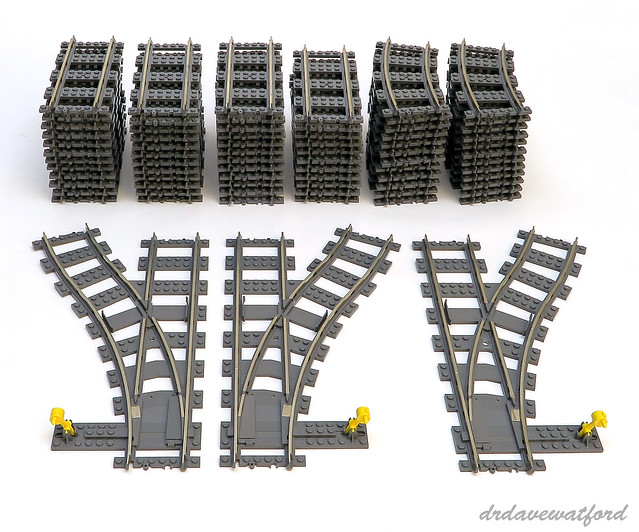
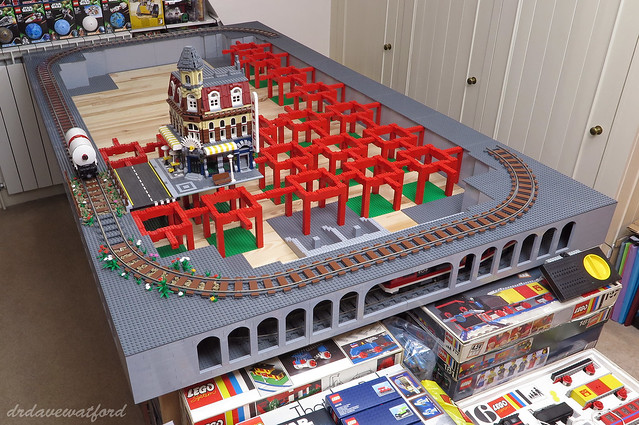
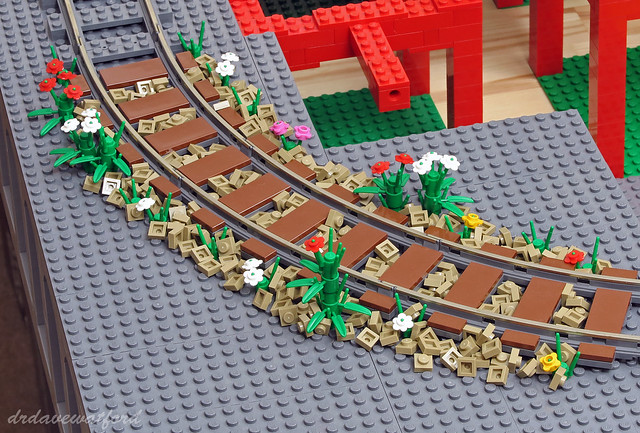
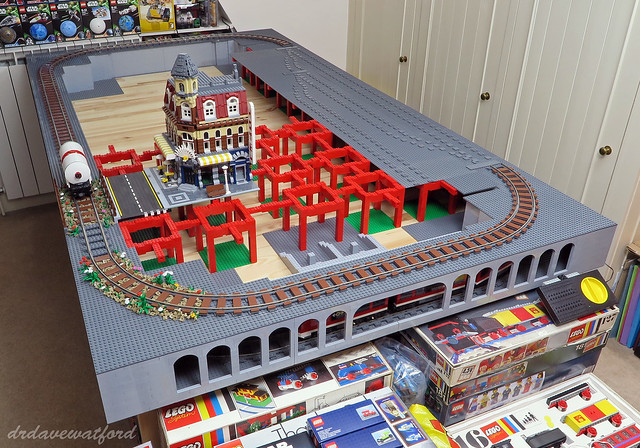
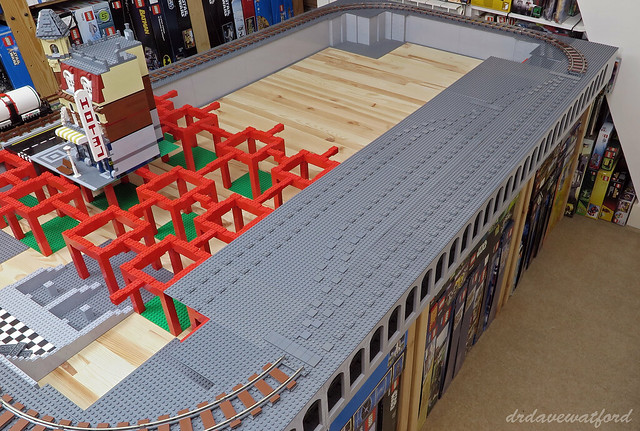
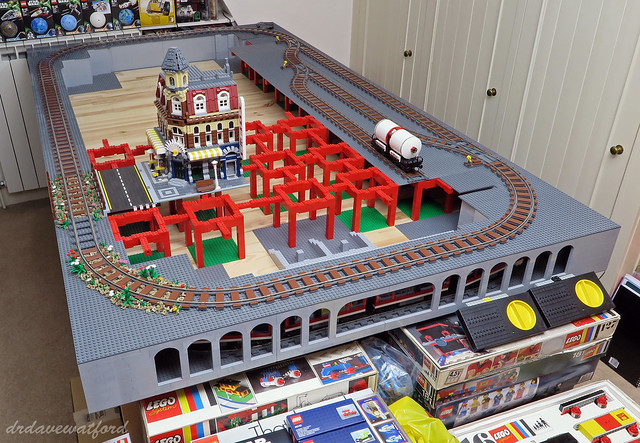
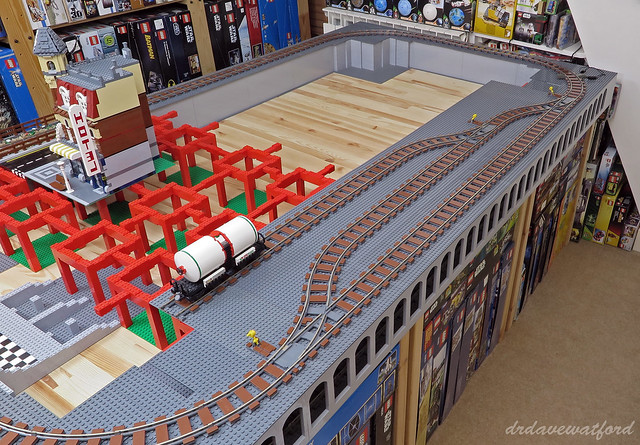
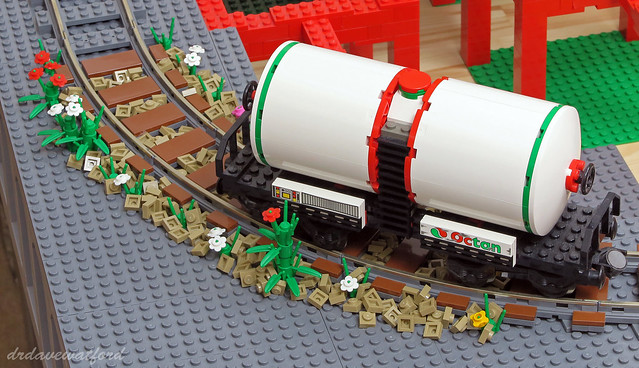
Looking Good :)
ReplyDeleteThanks, Nick!
DeleteDave, I'm sure you know this but I thought it worth mentioning that there's a company called ME Models which sell rail kits that are LEGO compatible. They look good and there was talk of 9V tracks as well but I'm not sure if that happened. There's a review of them over on Rail Bricks for the plastic tracks.
ReplyDeleteThe one thing I found problematic with 9V is the fact that they tarnish and stop working (besides the increased cost) but a little bit of brasso will clean them up and have the trains run smoother as well - if you're getting a little stuttering in places, try it on the affected tracks. If you get it on the plastic it tends to leave white residue but no harm to the plastic itself. Just be careful when cleaning as I've read about people whu cracked the metal when rubbing too hard.
Thanks, Brian - I was aware of ME Models but didn't realise that there was talk of 9V track. I suspect that they'd clean up if they could produce reasonable quality at an affordable price....
DeleteThanks also for the Brasso tip - I've noticed the motor stuttering on occasion and wondered whether it was the track or the motor. I'll certainly give Brasso a whirl.
They ran a kick starter for the project and it may have been a stretch goal but I'm not sure. I did see that on the kickstarter page there is talk of the metal track being produced but no timescales.
DeleteI've also heard/read that you can use aluminium foil tape on the PF track but you have to get it seamless - not sure if that'd work well.
Rather than aluminum foil, take a look at self -adhesive copper foil like that used for stained glass. It comes in rolls with widths as narrow as 3/16" (maybe even 5/32") and is fairly inexpensive.
ReplyDeleteJust checked... 5/32" is available...36-yard roll at delphi glass for $4.95 US.
DeleteIt all sounds a bit Heath Robinson to me, although there will likely come a time when it won't be possible to source genuine 9V track and it'll therefore be that or nothing....
DeleteWhat a great blog!
ReplyDelete